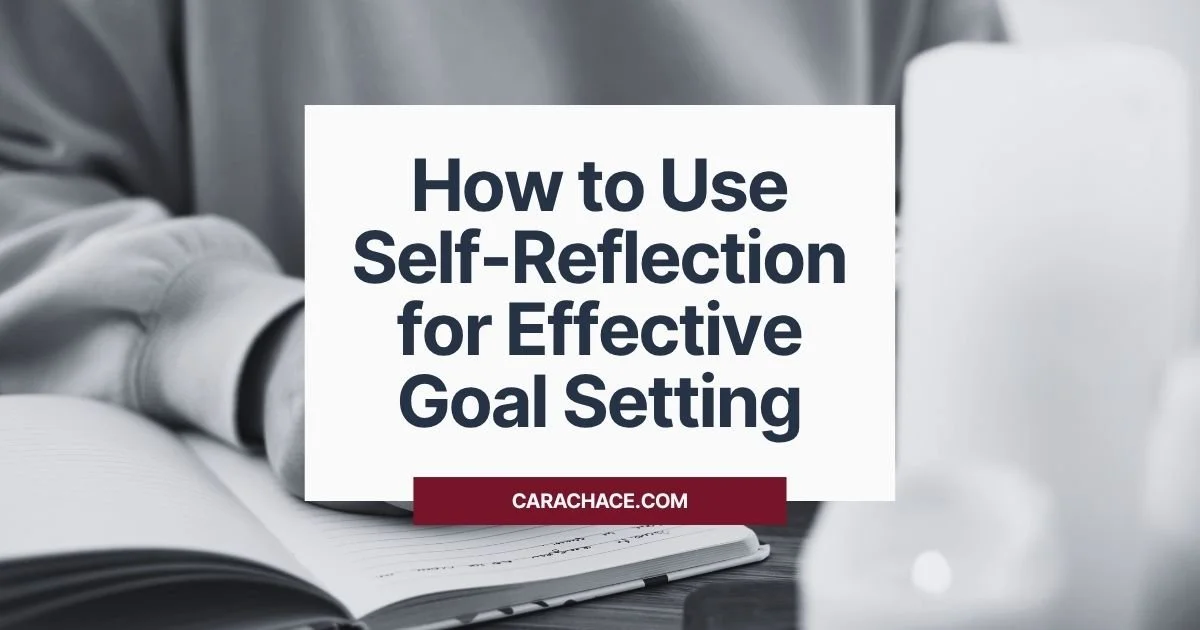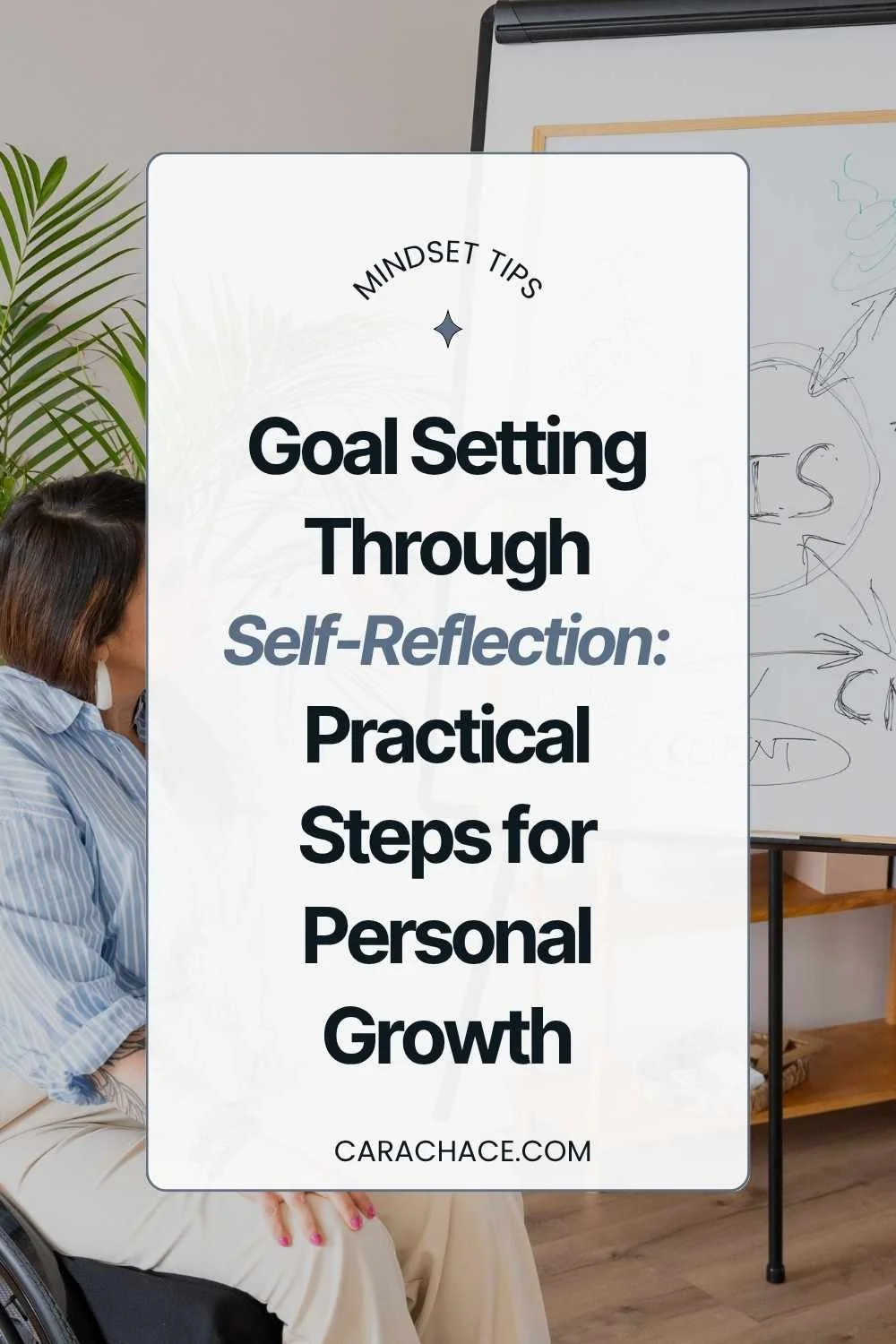How to Use Self-Reflection for Effective Goal Setting
Self-reflection isn’t just a journaling prompt—it’s your most overlooked productivity tool.
In a world addicted to checklists and hacks, self-reflection offers something deeper: clarity. It filters out noise, exposes patterns, and forces you to confront where your time and energy are going—versus where you say they should be going. But here’s the part most people miss: self-reflection only works if you do something with it.
If you’re a high-achieving woman with a calendar full of obligations and a brain full of open loops, what you don’t need is more planning. You need a process that helps you turn personal insight into intentional decisions. That’s where reflection ends—and goal setting begins.
This blog will show you how to turn self-reflection into a practical, repeatable strategy for setting meaningful goals that support your personal growth, motivation, and sustainable productivity.
Why Self-Reflection Is the Hidden Engine Behind Real Productivity
Most productivity advice skips the hard part: knowing what actually matters.
Self-reflection helps you uncover that. It reveals the disconnect between your daily choices and your deeper values. It shows you what’s draining your energy, what’s no longer serving your goals, and what patterns you keep repeating even when they lead to burnout. Without this clarity, goal setting becomes guesswork—or worse, someone else’s blueprint.
When you don’t reflect, your goals are reactive. You chase what’s urgent, trendy, or externally validated. But when you start with self-reflection, you build from alignment. You shift from cramming more in to clearing space for what moves the needle.
This is the foundation of Chaos Detox: mind management comes before time management. Reflection isn’t just about why you want change—it’s how you design change that actually sticks. And when your goals come from that internal clarity, you stop trying to fit into rigid systems that were never built for your life.
How to Turn Insights Into Aligned, Actionable Goals
Self-reflection is only powerful if it leads somewhere. Turning those insights into meaningful progress requires more than good intentions—it demands structure that fits your life, not someone else’s productivity plan. That’s why Chaos Detox doesn’t just stop at clarity. It helps you build a personal system using the MAP process: Mindfulness, Action, and Perseverance.
Here’s how to move from internal awareness to aligned action—without burnout or overcomplication.
Ask Better Questions to Clarify What Actually Matters
Before setting goals, take a pause and reflect intentionally. Ask yourself:
What needs to change—and what do I want to protect?
Where am I spending energy that gives me no return?
What patterns keep repeating, and what would I do differently next time?
What’s already working that I want to double down on?
These self-reflection exercises for goal-setting give you a clean starting point. You’re not guessing or copying someone else’s strategy—you’re starting from what’s real and grounded in your experience. That’s the foundation of any sustainable personal growth system.
Create Goals That Are Flexible, Not Fragile
Forget rigid deadlines or external benchmarks. If your life doesn’t operate in perfect blocks of time, your goals shouldn’t either.
Instead, set goals that flex with your energy, schedule, and values. For example:
Instead of “Journal every day,” try “Reflect three times per week using the MAP check-in.”
Instead of “Launch a new offer by Friday,” try “Complete the three highest-impact actions by end of week.”
This is how to turn self-reflection into action that actually works. You’re building from alignment, not urgency. And you’re using mindfulness to decide what belongs on your calendar before adding more to it.
Take Small, Strategic Steps (and Track What Works)
Every goal needs a frictionless first step. That’s where the Action part of MAP kicks in. Break down big ideas into micro-habits that are so simple they feel almost too small to matter.
That’s the point. Sustainable self-improvement doesn’t come from overhauling your life—it comes from stacking small shifts like:
Setting a 10-minute planning timer before bed
Using one focus block per day for deep work
Creating a “stop doing” list alongside your to-do list
These are actionable steps for personal growth that make momentum feel possible, not overwhelming.
Use Weekly Reflection to Rebuild—Not Start Over
This is where perseverance shows up.
Every week, revisit your goals and make space to adjust. Ask:
Did this strategy feel sustainable—or was it forced?
What helped me follow through—and what got in the way?
Do I need to shift the goal, the method, or the timing?
You’re not aiming for perfection. You’re building a system that evolves with you. That’s what makes this approach to goal setting mindful, productive, and deeply personal.
Review, tweak, and re-test—don’t rewrite the whole plan just because a day blew up.
And when you’re consistent with the MAP process—mindfulness, action, and perseverance—you stop falling off track and start building a version of productivity that holds, even when life doesn’t.
Trusted Frameworks to Stay Focused
Self-reflection is powerful, but it can drift into overthinking if there’s no system to channel it. The goal isn’t to analyze endlessly—it’s to use simple, repeatable frameworks that turn clarity into traction. These two tools help you focus, prioritize, and stay in motion.
The Four-Step Reflection Cycle
This minimalist process works whether you journal daily or reflect once a week:
Look Back: Pick a recent moment, pattern, or trigger.
Think: What worked, what didn’t, and why?
Learn: Extract one insight—no pressure to solve everything.
Plan: Choose one action or boundary to test next week.
This simple cycle turns loose thoughts into strategic action. It helps build mindfulness, supports personal development, and keeps your reflection grounded in movement—not just thought.
The “KNOWN” Effect
The KNOWN framework pulls you back to clarity:
Know what you want (clarity)
Narrow your focus (eliminate noise)
Own your capacity (set realistic expectations)
Work your strategy (one step at a time)
Notice what works (reflect + adjust)
You don’t need more motivation—you need a system that cuts the noise. These five checkpoints help you course-correct without starting over.
If frameworks like the Four-Step Reflection Cycle and the KNOWN Effect help you get clear and focused, Chaos Detox shows you how to make that clarity operational. It teaches you how to build a sustainable, personalized system—using the MAP process (Mindfulness, Action, and Perseverance)—that turns weekly insights into consistent, real-life follow-through.
These tools are powerful. But without a simple, adaptable structure to support them, most people slide back into overplanning or overwhelm. Chaos Detox is the system that holds everything together—so you’re not starting over every time life gets messy.
Make It Stick: Avoiding Common Self-Reflection Pitfalls
Real personal growth isn’t about setting better goals—it’s about building a process you’ll actually return to. That means avoiding the most common traps that make self-reflection feel good in the moment but lead nowhere over time.
Overthinking Without Acting
Don’t let your journal become a parking lot for insights you never use. Reflection is the first step—but if you don’t convert it into decisions, it’s just mental clutter in disguise.
Trying to Do Too Much at Once
One insight. One shift. That’s the move.
Stacking five goals on Monday morning after a great weekend reset? That’s a setup for burnout. Stick to one goal, one habit, or one boundary until it feels automatic. Then build.
Expecting Perfection Instead of Iteration
Your first version will be messy. That’s expected. Review, tweak, and re-test—don’t rewrite the whole plan just because a day blew up. This is how to turn self-reflection into action and sustainability.
Mixing in Other Methods Too Soon
This is where high-achievers get stuck.
You’ll be tempted to bolt other tools onto your system too early. Don’t. Adding planners, productivity apps, or other course strategies too soon will muddy your progress and confuse your brain.
If you find something that works, stay with it. You don’t need to layer five systems at once. In fact, most women get stuck not because they don’t know enough—but because they’re mixing too much too fast.
If you’re looking for one clean system that turns reflection into sustainable action, Chaos Detox is built for that. But no matter what path you take—commit to consistency over complexity.
You’re not behind—you’re building a new baseline. One you can trust.
Conclusion: Self-Reflection Is the Start—Not the System
Self-reflection is how you reclaim clarity. Goal setting is how you build direction. But the real change happens when you create a system that holds both—without relying on rigid routines or all-or-nothing energy.
When you take time to reflect on what matters, filter that into aligned actions, and stay flexible in the follow-through, your goals stop being aspirational. They become part of how you live and work.
If you’re ready to turn that clarity into something sustainable, Chaos Detox walks you through building a system that supports your energy, your brain, and your real life—not someone else’s version of productivity.
You don’t need more pressure. You need a better process.
Start Chaos Detox and take your time back—on your terms.
FAQS: Digital Overload & Productivity
-
Journaling captures thoughts. Self-reflection filters them into decisions. The goal isn’t to vent or document—it’s to pull insights you can act on.
-
If your goals come from urgency, comparison, or pressure—they’re reactive. Aligned goals feel clear, relevant, and sustainable without overhauling your entire life.
-
Use a framework. The Four-Step Reflection Cycle and KNOWN Effect help you move from awareness to action. If you want a system that holds those tools together, that’s what Chaos Detox is for.
-
Most systems add layers. This one strips them away. It’s built for women who don’t need more to do—they need a repeatable process that adapts to real life and protects their time and focus.
-
No—but if you want a clear, guided way to build your own productivity system from the principles of self-reflection first, it’s the next aligned step. Chaos Detox helps you design a workflow that’s unique to you—so you’re not trying to squeeze your life into someone else’s structure.
Related Posts:
Creating a Simple Online Business: How To Go From Complex to Clear
How to Avoid Shiny Object Syndrome: 5 Questions To Ask Yourself Before You Buy
Success Mindset: How To Be A Beginner
Liked this post? Pin it to Pinterest!
-
Self-Reflection: 300+ Powerful Prompts to Improve Your Clarity – Day One App
6 Steps to Crafting Your Personal Action Plan for Change – Chad Harvey
4 Steps for Reflection: Look, Think, Learn, Plan – Case Western Reserve University
The KNOWN Effect: How Self-Reflection and Goal Setting Drive Success – Vagaro Learn







